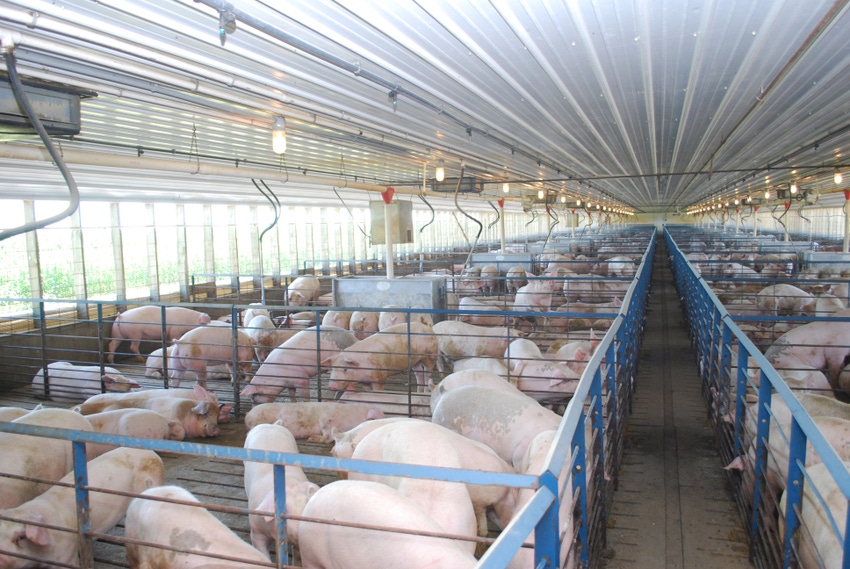More market hogs, fewer breeding animals
Total U.S. pork exports in 2023 are expected to be about 6.8 billion pounds, 6.6% above shipments in 2022.

Elevated input costs, weak consumer demand and animal welfare regulations that go beyond the states that created them have clouded 2023 producer returns. Prices for January through August live equivalent 51-52% lean hogs averaged year-over-year lower, and Iowa State University’s Estimated Livestock Returns suggest that break-even costs are not likely to be covered until the spring of 2024. Thus, the reason the industry saw more market hogs and fewer breeding animals in the September Quarterly Hogs and Pigs Report, says USDA ERS Agricultural Economist Mildred Haley in the Livestock, Dairy, and Poultry Outlook for October 2023.
Farrowings in March–May were 98% of a year earlier, while June–August farrowings were down 4%. Producer efforts to keep pig numbers below last year’s levels seemed to be offset however by the decrease in cases of porcine reproductive and respiratory syndrome at key points of the year, according to data from the Swine Health Information Center.
Steady-to-larger pig crops have also increased the available supply of market-ready hogs to markets trading at often-below costs of production levels, Haley notes.
“In both the March–May and the June–August quarter of this year, lower farrowings (-2% and -4%, respectively) resulted in pig crops measuring 101 and 100% of those of a year earlier, each amplified by litter rates 3% higher year over year in March–May and 4% higher year over year in June– August,” Haley reports.
Fourth-quarter pork production is expected to be about 7.2 billion pounds, almost 4% greater than a year earlier. Larger hog supplies should also reduce prices, she says.
“Prices of live equivalent 51-52 percent lean hogs are expected to average $58 per cwt, almost 9% below the fourth quarter of a year ago and below break-even prices for most U.S. pork producers,” Haley reports.
However first-quarter hog prices are expected to be year-over-year higher at $60 per cwt, more than 9% above same-period prices this year.
“Despite higher production, hog prices are forecast higher as a result of both increased competitiveness of pork vis-à-vis other meat proteins in the domestic market and increased foreign demand for U.S. pork,” Haley notes. “This is the consequence of the expectation that the European Union will continue to reduce its pork exports due to declining production.”
In the September Hogs and Pigs report producers indicated intentions to farrow 5% fewer sows in the September–November 2023 quarter than a year ago. Haley says if producers follow through on these second intentions, Q2 2024 pork production should approach 6.6 billion pounds, slightly smaller than a year earlier. “The small decline in production should push up hog prices to $64 per cwt, almost 13% higher than a year earlier.”
For the Q1 2024 producers indicated intentions to farrow 2.912 sows in the December–February period, down about 1.4% from December 2023 farrowings. If producers follow through with their intentions stated in September, and assuming moderate increases in trend litter rates and average dressed rates, third-quarter pork production would reach about 6.8 billion pounds, 4.7% above this year’s third-quarter production.
“Larger production should pressure hog prices to $65 per cwt, more than 6.2% lower than third-quarter prices this year. Pork production in 2024 is expected to total about 27.9 billion pounds, a 2.2% increase above forecast production this year. Live equivalent prices of 51-52% lean hogs should average about $61 per cwt, 2.6% above total average prices in 2022,” Haley notes.
Exports make headway
U.S. pork exports in August were 527 million pounds, 2.6% greater than in August 2022. Shipments to Mexico were dominant at 209 million pounds, and they accounted for 40% of August exports. Shipments to most other Western Hemisphere countries were also year over-year higher: Canada (+19 percent), the Dominican Republic (+26 percent) and Honduras (+12 percent).
On the other hand, with the exception of Japan, shipments to Asia were generally weak.
“It is possible that some countries such as the Philippines and Colombia may have been responding to higher mid-summer wholesale pork prices, and to the appreciating U.S. dollar, which continues to react to the increasing U.S. interest rates. It is notable that the Federal Reserve’s Broad Dollar Index has been appreciating since July after months of relative stability, thereby reducing the competitiveness of U.S. products in foreign markets.”
Another possible explanation may be the European Union’s reductions in both its production and exports of pork. Since 2021, when EU pork production was 23.615 million metric tons, the EU has reduced its production to a point where USDA forecasts 2024 EU pork production at 21.150 mmt, a reduction of almost 2.5 mmt, or more than 10% in three years.
“Reduced production is attributable to high production costs brought about largely by increased energy costs, which in turn have been brought on—partially—by the war in Ukraine. Energy costs have also been increased by efforts to reduce fossil fuel usage at all points of the pork supply chain, including feed costs, as a lead-up Farm-to-Fork component of the European Commission’s Green Deal,” Haley notes. “The resource use restrictions and new animal welfare rules contained in the new regulations will increase pork production costs, necessitating output reductions that will in turn lead to smaller exportable pork surpluses.”
Total U.S. pork exports in 2023 are expected to be about 6.8 billion pounds, 6.6% above shipments in 2022, accounting for 24.8% of 2023 commercial production.
Based on revised production and price assumptions, exports in 2024 are anticipated to rise to 6.950 billion pounds, which will cover 24.9% percent of commercial production.
About the Author(s)
You May Also Like





